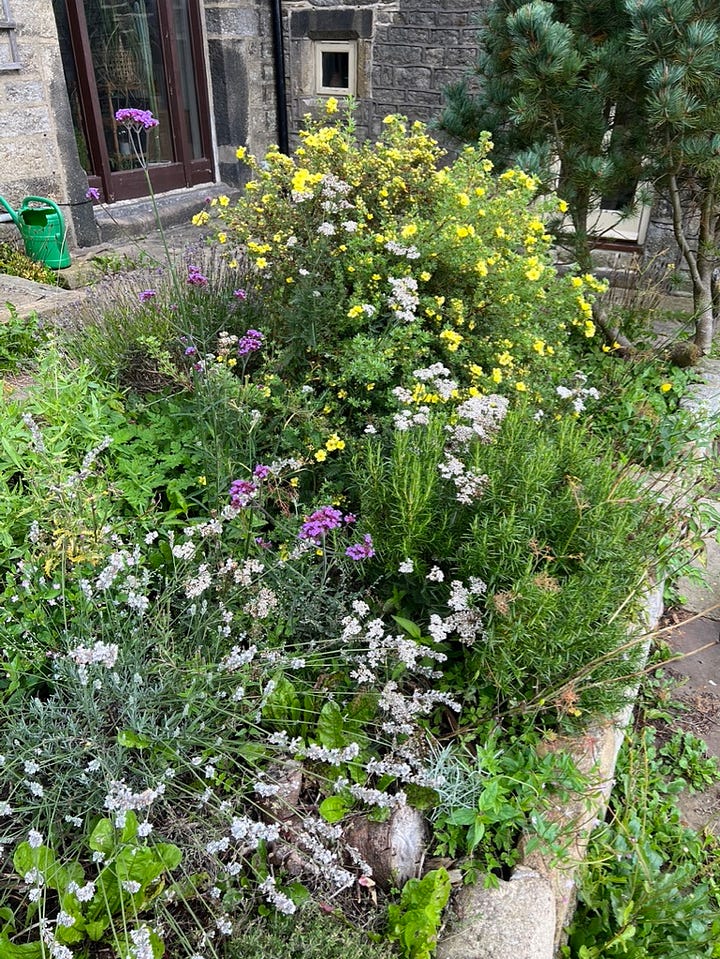

This week I was blown away by the buzz around the Succisa pratensis I’d grown from wild seed collected locally two years ago. Devil’s bit scabious is one of my favourite wildflowers. What I hadn’t appreciated is how much it’s loved by hoverflies. On Wednesday morning in the sun, the five plants were smothered in various species of hoverfly and wild bee, hundreds at once. The hum vibrated through the air loudly, I had never heard such a loud humming from insects in the UK before. My love of this plant, which I already planned to spread around in wilder spots, shot up.
The sun is back a little, though it still feels autumnal.
I love our patch of amber sunflowers, adding to the autumnal vibes. But not yet seasons! Not yet.
Earlier in the year we received consent to extend a small 1.5m wide strip of old patio to make it more usable. It was so narrow that with chairs on, you couldn’t even walk around them. Our friend and fellow allotment holder Graham, who is a talented builder, has begun work on it for us, which is really exciting. It’s only going to be extended by another slab or so but it means this pretty unusable area will be big enough for a table. I’m looking forward to continuing to plant up around it when finished. There will be lots of white flowered plants to glow against the hedge.
Materials wise, we’re using reclaimed local stone, mostly reusing spare stone already piled up here from when the patio was first made in the past. Our local stone is called millstone grit and is a very gritty sandstone with a light sandy colour, though that fades to the grey above in the weather. This is the only hard landscaping work we’ll do as we’d like to keep the farm for plants and wildlife. As a designer, I’ve never been that focussed on hard landscaping, it often feels unnecessary when plants are where the magic happens. It is however nice to have at least one area for people to use that feels solid underfoot year round.
If you look closely in the photo above, next to the obvious Miscanthus and Pulmonaria, there are also multiple young plants of Astrantia, Helleborus, Brunnera, Fuchsia, Geranium and Eurybia. I’m interested in this area because as you can see, there is a lot of dandelion, creeping buttercup and couch grass swamping it. The plants I’ve added are slowly but surely starting to push back as they establish within the plant community. I suspect that in a year’s time, the plants I’ve added will outcompete the others. I’m not going to thin the unwanted plants here too much to see if that does indeed happen and we’ve learnt something to save effort elsewhere.


It’s early days for the herb garden while the shrubby herbs grow bigger, such as the rosemary and sage. It’s looking great though and I’m enjoying the colour of the flowers. Most plants are edible with a few inedible ornamentals for added flower power, such as the Potentilla fruticosa and Verbena bonariensis.
A couple of years ago, in an old trough in the drive I added the small white flowered water lily, Nymphaea 'Candidissima', which has begun flowering for the first time.



This week the Helenium trial at RHS Bridgewater started up again for the second year out of three. Bridgewater, in Salford next to Manchester, looks particularly amazing right now with lots of modern plant selections and plenty of wildflower areas to browse and investigate. I’m hoping to go back in the next week or two between trial judging.


The trial area is really hotting up with a great Hydrangea trial and Helenium looking absolutely spectacular! I was excited to join this trial, after being on the Persicaria trial at RHS Wisley, because Helenium are a group of plants I’ve been exploring myself over the last five years or so. First drawn to the burnt orange colours, the trial has piqued my interest in dark reds and light yellows. The main takeaway I have from the trial this year is wow, I didn’t know so many grow so absolutely ginormous! Well over head height and there are lots of reliable cultivars among them. We’re still early in the trial and I don’t want to recommend any specific cultivars just yet, as they could turn out to be duds! However, I have this week expanded my own collection at home where I am trialling a number in an exposed location without staking. The big downside to Helenium is that it’s recommended they are staked no matter their size due to the fragility of their stems. All of the very tall plants in the trial are staked. In our garden at home I don’t want to use any stakes on ornamental plants, which could mean long term we won’t grow them. We shall see.
In case you missed it, the WILD WAY: AUGUST 2023 magazine issue for paid subscribers includes a look at the main plants in our garden and 14 of my trusted summer edible plants.
WILD WAY: AUGUST 2023
COLOUR CHAOS Our garden is starting to emerge, and with it, a look that’s at one time how I imagined, and another, mostly plants doing unexpected things. I find this a constant joy when planning planting schemes, that you set things on a course and then nature does what it wants. A few of the main plants featured in these photos include: in the middle









